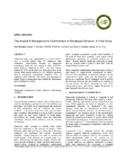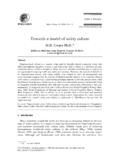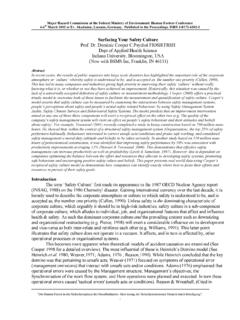Transcription of Measuring and Improving Safety Culture
1 Measuring and Improving Safety Culture Published in: The ESH Handbook for the Public Sector - 1996/7 Dr Dominic Cooper AFBPsS MASSE MIIRSM FIOSH FRSH B-Safe Management Solutions Inc, 6648 East State Road 44, Franklin, IN 46131, USA. Abstract Perceptions and beliefs, behaviour and management systems are the elements which combine to form an organisation's ' Safety Culture '. Dr Dominic Cooper considers their significance to achieving the goal of good Safety management. Introduction Because good Safety management is good business management, the challenge of Improving an organisation's Safety Culture is a top priority in many companies. Since the prevailing ' Safety Culture ' determines the way Safety issues are addressed in an organisation, one of the first requirements must be to know what it is.
2 The Confederation of British Industry (CBI) described it as 'The way we do things around here'. It may be more fruitful, however, to view it as 'the product of the reciprocal relationship between employees' perceptions and beliefs, their ongoing Safety behaviour and the available Safety management systems' (see figure 1). The advantages of this perspective reside in the fact that organisations can readily measure, analyse and monitor each of these three elements, so that they can control their Safety activities in a highly focused manner. Figure 1: Reciprocally Determined Model of Safety Culture Safety Climate Safety climate is concerned with the shared perceptions and beliefs that employees hold regarding Safety in their workplace. These serve to construct a self-sustaining image of risk, danger and Safety in an organisation.
3 Although, Culture alludes to organisational behavioural norms, climate refers to people s specific descriptions of their everyday experiences with these norms. As such, Safety climate reflects employees perceptions and beliefs about the organisations Safety management practices and systems. Researchers have shown that those organisations with a good Safety climate tend to have fewer accidents, and vice versa. It makes sense, therefore, to measure the prevailing Safety climate via psychometric surveys, so that any deficiencies in Safety management practices and systems can be identified. The results enable management to direct their attentions to poor communications, weaknesses in Safety procedures, gaps in training, etc. These diagnostic surveys are extremely useful management tools, that provide an ideal aid for focusing Safety improvement efforts, prior to implementation, as well as in determining the impact of Safety awareness campaigns, Safety training, and behavioural Safety programmes, which, hitherto, has proven to be very difficult.
4 Behavioural Safety For many years Safety professionals have been aware that 80-90% of workplace accidents are triggered by unsafe behaviours. Controlling unsafe acts is one of the keys to successful accident prevention, but many organisations are frustrated by their inability to control them, even those with low accident rates. Traditionally, organisations have relied on a combination of publicity campaigns, Safety training, and discipline to change people s attitudes, so as to change their behaviour. Although these approaches have their place, in themselves they are not efficient methods for managing a change in either attitudes or unsafe behaviour. The best way to address unsafe behaviour and poor Safety attitudes to bring about the desired change, is to focus solely on Safety behaviour, not Safety attitudes.
5 Attitudinal change automatically follows behaviour change, whereas behavioural change does not necessarily follow attitude change. By adopting Safety behaviour as the unit of measurement, organisations can use proven management techniques to bring about significant and long-lasting improvements in their Safety Culture . This entails adopting a collaborative, problem-solving approach involving both management and employees to identify critical sets of safe and unsafe behaviours. These are used to develop Safety Behaviour Inventories , which personnel use to systematically monitor their colleagues ongoing Safety behaviour, in a participative atmosphere. Based on the results of the peer monitoring, workgroups set their own collective Safety improvement targets.
6 Information feedback is then provided weekly to allow the workgroups to track their progress against the Safety targets. Typically, organisations adopting this approach become proactive Safety managers, which is usually rewarded by less accidents, consistent Safety management, better communications and greater involvement in team-working. Regardless of the industrial sector, scientific evaluations of this approach to behavioural Safety have reported:- Organisational Improved levels of Safety performance; Reductions in accident rates; Significant reductions in accident costs; Improvements in co-operation, involvement and communications between management and the workforce; Improvements in an organisation s Safety Climate; Ongoing improvements to Safety Management Systems.
7 Person Enhanced ownership of Safety by the workforce; Improvements in Safety behaviour and attitudes towards Safety ; Enhanced acceptance of responsibility for Safety ; Improved understanding of the safe behaviour and accidents relationship. As these findings suggest, Improving Safety by focusing on specific behaviours lead to many positive results, for both organisations and individuals. Emphasising continuous improvement, behavioural Safety programmes also incorporate the principles and philosophies of the Total Quality Management movement. Safety Management Systems Safety management systems are integrated organisational mechanisms designed to control health and Safety risks, ongoing health and Safety performance, and legislative compliance. In principle, a good Safety management system should be a fully integrated and cohesive system, centred around policies, strategies and procedures that provide internal consistency and harmonisation.
8 The development of such a system should be seen as a practical way of creating the awareness, understanding, motivation and commitment of all personnel, while also optimising an organisation s health and Safety performance per se. In this way Safety becomes everyone s responsibility. Nevertheless, because Safety management is dependent upon many organisational activities, this diffusion of responsibility requires every activity to be reviewed and integrated into a holistic process. This can be achieved by auditing the Safety management system to ensure the reliability, efficiency and effectiveness of an organisation s policy-making, planning, organising, implement, monitoring and reviewing of Safety performance. The audit findings constitute the feedback loop needed by the organisation to shape, maintain and develop its ability to manage and control risks to their fullest extent.
9 Although posing considerable challenges which may mean changes to management systems, communication systems, management styles and competencies, auditing and performance reviews are crucial steps in achieving organisational success in Health and Safety . As once said by a Greek sage The first step to wisdom is to know thyself . And so it is with Improving organisational Safety Culture : To know an organisations present strengths and weaknesses requires the Measuring , analysing, monitoring and reviewing of various interrelated Safety activities. In many instances, organisations are clear about how to do so with their Safety management systems. Unfortunately, they are less clear about how to examine people s perceptions and attitudes or behavioural Safety issues.
10 I hope that this article has shed some light in these areas.




